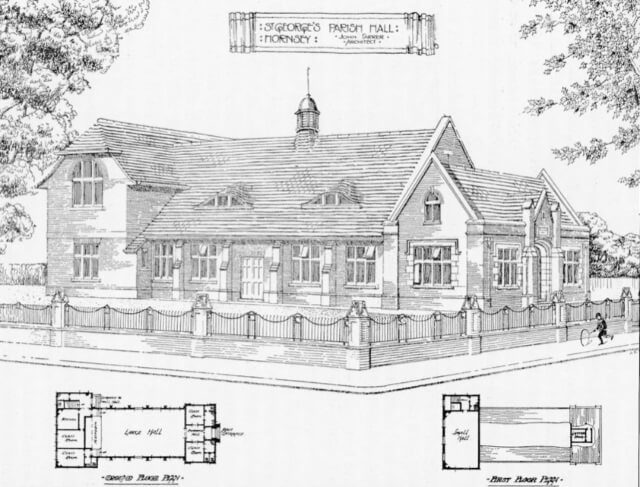September 1928, aged five, my mother took me across Cranley Gardens to St. George’s Hall for my first day at school. At that time there were no nursery or play schools to help prepare a child for this big day.

The hall was an annex to Crouch End High School and College which was in Elm House, Middle Lane facing the end of Palace Road, it catered for boys and girls from ages five to seven. On returning home mother wanted to know how I had got on. I uttered the immortal words: “Bobby kicked me”. Happily things improved and I received my first proposal of marriage. We plighted our troth by exchanging farthings.
The small hall downstairs had a heavy movable divider, this was pulled across to make two small classrooms. Here I fought the first of many losing battles with arithmetic. I learnt that 2+2 =4 and 2×2 =4 also. It therefore followed that when 3+3 =6 then 3×3 =6 also. Teacher said that it equalled nine but that made no sense. The larger upstairs hall was used for games. These halls were the only sections to survive the flying bomb which fell on the night of June 16, 1944 destroying the large main hall and all the shops on the west side of Park Road. It also severely damaged our house. Concerts were performed on the stage of that hall. One year we performed A.A. Milne’s playlet “The King’s Breakfast“. I was the narrator. We rehearsed in the daytime and nothing prepared me for the shock I received when the curtains opened in the evening and I was unable to see the audience. I am still asked to take part in concerts on that stage which must be some sort of record.
Time came to move on to the main school which was for girls only. The boys possibly attended a boys’ school which was adjacent in Rokesley House on the corner of Middle Lane and Rokesley Avenue. I used to pedal along Park Road on my fairy cycle in those halcyon days of little traffic. On arrival I would park my bike round by the kitchen door and be greeted by Yoyo, the school dog, named after the latest craze sweeping the country.
Confession time. On one occasion a girl goaded me once too often and this resulted in a fight in the cloakroom. A teacher arrived and separated us and feeling thoroughly sheepish we were made to shake hands. I do not recall any serious bullying or truancy at any time during my schooling and there was certainly never any corporal punishment. One look from a teacher was enough to put the fear of God in us. I landed in trouble on another occasion and unfairly blamed my grandmother. She was bedridden and used to give me money to buy her sweets on my way to school at the little sweetshop on the corner of Harefield Road opposite the swimming pool. (I still feel a twinge of sadness when I see its bricked-up entrance today). In class temptation got the better of me and I dipped into the bag. Caught in the act I was hauled up in front of the class in disgrace and made to stand behind the blackboard for the remainder of the lesson.
On the whole I was a good little girl and certainly worked hard actually winning two prizes. These were distributed on prize giving days very often by Dame Madge Kendall, a well- known actress of the day, who was a frequent visitor to the school. Little ribbons were pinned on our uniforms; these were of different colours depending on the subject for which the prize had been won. Our uniforms were fawn and blue and the school emblem was a cornflower. Teachers too could fall off their pedestals in my young estimation. On my first day I asked where the morning milk was. The teacher’s answer was: “You’re not a baby are you!” I was very upset. (When I went on to Hornsey High School I felt vindicated when I found my milk back on the menu.)

One day there was a violent thunder storm and our French teacher was so terrified she deserted our class and shut herself in a cupboard. To this day I have never quite forgiven the teacher who read us W.W. Jacob’s famous horror story, The Monkey’s Paw. It certainly has a strong moral message in that we should be careful what we wish for but it gave me nightmares for years to come.